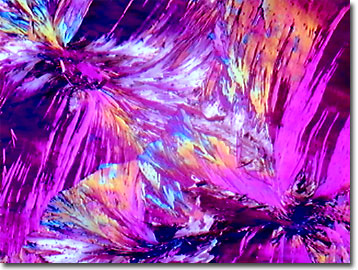Polarized Light Digital Image Gallery
Docosahexaenoic Acid (DHA)
Docosahexaenoic (or docosahexanoic) acid (DHA), one of the omega-3 fatty acids, appears to possess beneficial influences on human visual function and may be important in the infant diet. The triple long-chain polyunsaturated fatty acid DHA is one of the least saturated fatty acids in the human body, and is highly enriched in the membrane lipids of rod photoreceptors in the human eye, but also concentrates in the brain. Docosahexaenoic acid, sometimes referred to by nutritionists as "brain oil," is one of the primary structural components of brain tissues, which are 60 percent fats.

View a second image of docosahexaenoicacid.
Naturally found in fish oils, such as cod liver, tuna, and mackerel, as well as some organ meats and eggs, docosahexaenoic acid is also synthesized in the laboratory and available as a commercial dietary supplement. One form of DHA is extracted from microalgae grown under tight controls and offers a vegetarian source for the fatty acid. In nature, docosahexaenoic acid acts as "antifreeze", and in general, the colder the water, the higher the omega-3 fatty acid content of the fish oil and seaweeds. The essential fatty acid, alpha-linolenic acid, provides the stock in the human body for the biosynthesis of DHA and the related omega-3 fatty acid, eicosapentaenoic acid (EPA), but many humans have depressed enzyme activity for their production.
Patients exhibiting retinitis pigmentosa have DHA levels in their red blood cells that are significantly reduced (40 percent less) from that of normally sighted people. Statistical analyses show a significant correlation between cone photoreceptor function and red blood cell docosahexaenoic acid levels. For normal vision to develop, DHA must accumulate in the retinal membranes. For pre-term infants fed commercial corn oil-based formula instead of breast-fed milk or DHA-enriched formula, delayed responses to light stimuli have been observed. In contrast, cow milk is high in saturated fats and low in DHA concentration. From other studies, adult dyslexics show poorer dark adaptation than normal adults, and if given docosahexaenoic acid as a dietary supplement (480 milligrams per day), scotopic vision improves significantly.
The balance of fatty acids in various diets around the world may reflect varying risks of breast cancer. Other health attributes for high docosahexaenoic acid intake include reduced heart disease, reduced blood triglycerides, partial reversals in diabetes mellitus, attention-deficit hyperactivity disorder, depression and schizophrenia treatments, and possible delays in the onset of autoimmune disease (primarily AIDS).
Contributing Authors
Omar Alvarado, Thomas J. Fellers and Michael W. Davidson - National High Magnetic Field Laboratory, 1800 East Paul Dirac Dr., The Florida State University, Tallahassee, Florida, 32310.
BACK TO THE POLARIZED LIGHT IMAGE GALLERY
BACK TO THE DIGITAL IMAGE GALLERIES
Questions or comments? Send us an email.
© 1995-2025 by Michael W. Davidson and The Florida State University. All Rights Reserved. No images, graphics, software, scripts, or applets may be reproduced or used in any manner without permission from the copyright holders. Use of this website means you agree to all of the Legal Terms and Conditions set forth by the owners.
This website is maintained by our
Graphics & Web Programming Team
in collaboration with Optical Microscopy at the
National High Magnetic Field Laboratory.
Last Modification Friday, Nov 13, 2015 at 01:19 PM
Access Count Since September 17, 2002: 8516
Visit the website of our partner in introductory microscopy education:
|
|
